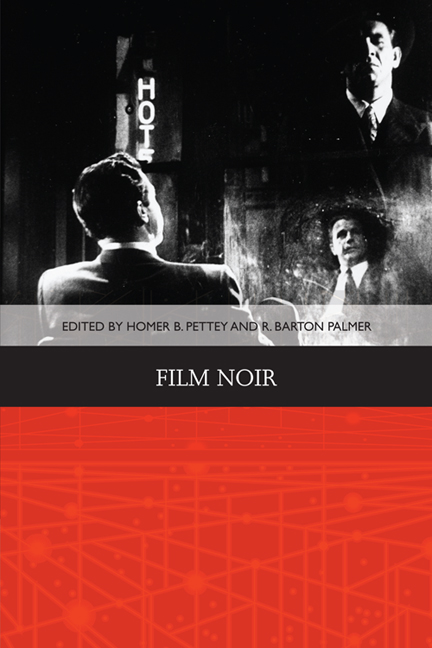Book contents
- Frontmatter
- Contents
- List of Illustrations
- Acknowledgements
- Notes on the Contributors
- Introduction: The Noir Turn
- 1 The Cinema of Uncertainty and the Opacity of Information from Louis Feuillade's Crime Serials to Film Noir
- 2 Warning Shadows: German Expressionism and American Film Noir
- 3 Hard-boiled Tradition and Early Film Noir
- 4 Cold War Noir
- 5 Noiring the Pitch: The Conflicted Soundtracks of Out of the Past, The Blue Gardenia and The Long Goodbye
- 6 Split Screen: Sound/Music in The Stranger/Criss Cross
- 7 Gender and Noir
- 8 The Subversive Shade of Black in Film Noir
- Postscript: A History of Our Writing about Film Noir
- Selected Book Chapters on Film Noir
- Selected Film Noir Books
- Selected Guide to Film Noir
- Index
Introduction: The Noir Turn
Published online by Cambridge University Press: 05 August 2016
- Frontmatter
- Contents
- List of Illustrations
- Acknowledgements
- Notes on the Contributors
- Introduction: The Noir Turn
- 1 The Cinema of Uncertainty and the Opacity of Information from Louis Feuillade's Crime Serials to Film Noir
- 2 Warning Shadows: German Expressionism and American Film Noir
- 3 Hard-boiled Tradition and Early Film Noir
- 4 Cold War Noir
- 5 Noiring the Pitch: The Conflicted Soundtracks of Out of the Past, The Blue Gardenia and The Long Goodbye
- 6 Split Screen: Sound/Music in The Stranger/Criss Cross
- 7 Gender and Noir
- 8 The Subversive Shade of Black in Film Noir
- Postscript: A History of Our Writing about Film Noir
- Selected Book Chapters on Film Noir
- Selected Film Noir Books
- Selected Guide to Film Noir
- Index
Summary
Without question, you try to learn from everybody you possibly can. You look at everything; you research everything. You know how I started ‘film noir’? –; of course I didn't know it was ‘film noir’ until the French told me but you know how I started it? I wanted to get a high-key-low-key lighting and looked through a copy of Daumier's works. Those of you who know Daumier know the kind of paintings he did. I showed it to my photographer and I said, ‘This is the kind of effect I want in this picture: very deep shadows and very hot lights’. That's how it started. It was our version of Daumier. It wasn't an original version at all and it wasn't exactly the same; but it was close, and I've done the same thing with other situations.
Edward Dmytryk, ‘On influences’So Dmytryk informed his audience in 1980 at the University of Texas about the original moment of inspiration for his evolving noir aesthetic. That Dmytryk chose Honore Daumier as the basis for film noir is hardly surprising, since Daumier's works not only exhibit what would become the noir visual style, but also contribute to the noir sensibility, its Weltanschauung and its social commentary. Moreover, Dmytryk and Daumier found themselves at odds with their governments for their sardonic critiques of economic repression and political hypocrisy. By referring to Daumier's style, Dmytryk also invokes Honore de Balzac's sardonic realism in La Comédie humaine, since Daumier illustrated Balzac's works and both he and Balzac contributed to La Caricature in the 1830s. Not surprising, then, that aesthetic experiments of modernism in the nineteenth century would attract the critical and cinematic eye of film noir directors and be the basis for the evolution of the art form. As evidenced by French cinema from the 1930s, film noir was already a term applied to films with subversive accounts of the ‘black despair of a hopeless life’, as Georges Altman concluded of Le Jour se lève in 1939: ‘Actors, theme, and words are cast and bathed in images which are never common, banal, or pernicious. A film noir, but that's as it should be’. That concept of a noir vision, as Dmytryk admits, depended upon the transmutation of style and content from antecedent artistic movements and texts, an evolutionary process both imitative and original.
- Type
- Chapter
- Information
- Film Noir , pp. 1 - 15Publisher: Edinburgh University PressPrint publication year: 2014



